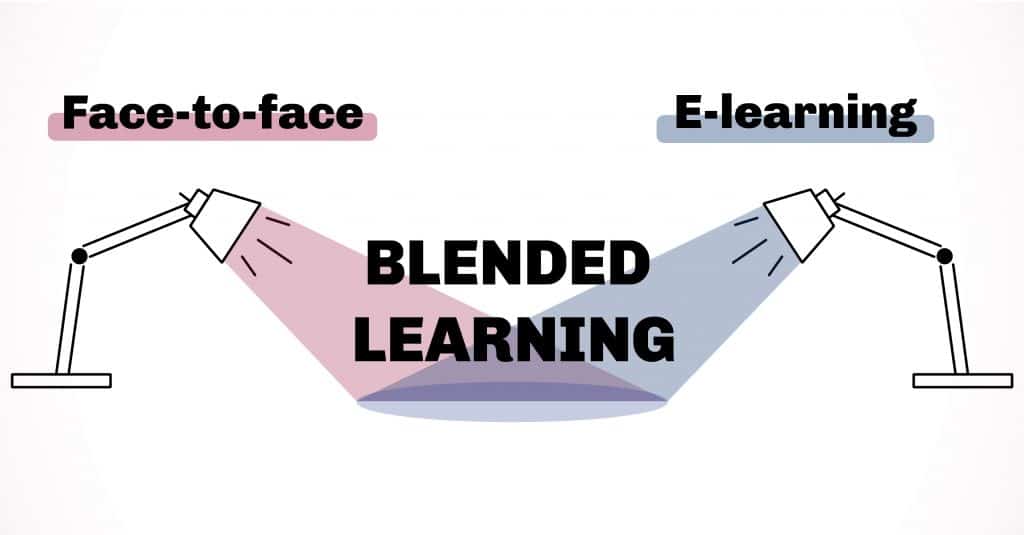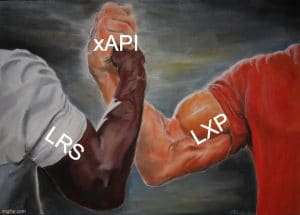What is blended learning?
Blended learning is a combination of digital and face-to-face training.
It is a broad concept, which can be structured around a panel of distinct elements such as LMS/LXP, learning platforms, videoconferencing, collaborative tools, follow-up and coaching platforms, etc…
It is an expanding model that is attracting more and more companies of all types, especially thanks to the results it allows to achieve compared to standard models (e-learning, 100% face-to-face).
Why blended learning?
There are lots of advantages for blended learning that have a significant impact on both the learners and the trainers.
For learners, blended learning allows them to become more autonomous thanks to dedicated platforms, to manage their time (and schedule) more easily and to access training materials anywhere in the world at any time, all without losing the relationship with the trainer.
For companies and trainers, blended learning will bring more flexibility (in the structure and delivery of the programs), allowing a significant cost reduction often linked to the organizational side of face-to-face training (logistics, travel, accommodation…).
Generally speaking, blended learning allows time and efficiency gains for the different actors of the training, without sacrificing the relational aspect nor the follow-up (individual or collective). It also allows a precise follow-up of the learners’ progress, which is often difficult to obtain in traditional training courses.
Qigu and blended learning
For a successful blended learning experience, it is therefore necessary to succeed in exploiting the full potential of this method by combining the advantages of face-to-face learning and the digital approach of a learning path.
Thanks to Qigu Drive, you have the ability to create and manage a blended learning course as a whole. Qigu includes all the tools and functionalities you need to create and distribute a blended learning path from A to Z.
All you have to do is imagine your ideal training program!
Here are some keys to help you succeed.
The 10 key points to remember to implement a successful blended learning training:
- Determine objectives – have a clear vision of what you want to achieve from the very beginning of the training creation phase.
- Choose the tools to achieve those objectives – know the tools that will technically achieve what was designed on paper.
- Structuring the course – designing and structuring a training course is like telling a story (storytelling). Having a clear and defined structure will keep the learner interested.
- Creating content – the structure of the course is the shell, and the content becomes the heart of the course. The content must be interactive and allow for changes of pace during the course.
- Stimulate interactions – keep the link between learners outside of face-to-face sessions, promote group collaboration.
- Personalization – personalize the training form (custom design, branding…) but also the experience of each learner by adapting the training to his/her evolution.
- Accompanying the learners – Maintain regular contact between the trainer(s) and the learners. Avoid leaving the learners alone in the face of the challenges they will encounter.
- Give feedback – as a trainer or as a learner, every feedback is good to take.
- Evaluate learners – monitor their progress, get a sense of their difficulties and give them the keys to success.
- Reward learners – value success, involvement, consistency.
The Qigu suite allows you to meet the above criteria thanks to the range of specific tools that make it up. Contact us to take a tour!
Avoid the pitfalls of digital
When we talk about digital training, the problems encountered and their consequences on the objectives set are recurrent but can be easily identified:
- The lack of follow-up from the trainer(s), as well as the lack of exchange with other learners leads to a feeling of loneliness in front of the training and a loss of motivation over time. This is why the trainer must be competent, especially in the use of digital tools to keep the learners motivated and enthusiastic.
- The generational gap can lead to a break, especially when using digital tools. Care must be taken not to complicate the training and to make it as intuitive as possible.
- Autonomy and personal investment may vary from one learner to another. It is therefore necessary to be able to adapt the training to each individual (in terms of content, time) while keeping an overall structure common to all learners.
In conclusion
It is necessary to find the right balance between face-to-face and digital training, but also to use digital tools in line with the objectives set at the beginning of each learning path.
Thanks to an efficient Blended Learning strategy and adapted digital tools, it is now possible to adapt to the needs of learners and learners by stimulating and enhancing their progress in the learning path for some, and by keeping a personalized and precise follow-up for others.
Sources:
https://culture-rh.com/blended-learning-definition-etapes-avantages-inconvenients/
https://elearningindustry.fr/strategie-blended-learning-efficace
Crédits photos : Dreyer Frederic






